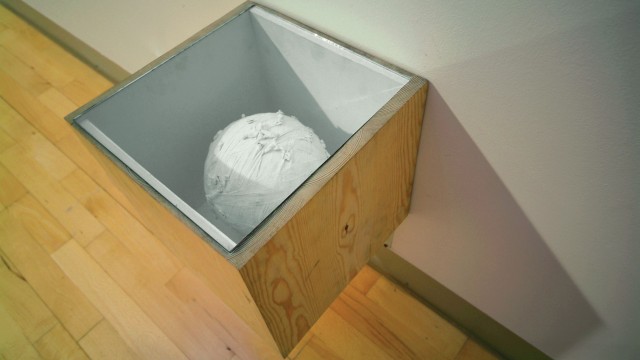
Concentrated Life
Circles, spirals, cones, and spheres repeatedly and significantly punctuate the work of Younes Rahmoun. Inspired by nature, these forms evoke fruits, the earth, and the rotation of the sun, the moon, and the planets. They are also and above all an homage to the atom, which for the artist is the supreme symbol of vital energy and the creative and transcendental force.
In 2004 at the French Institute in Fes, Younes Rahmoun exhibited a sphere made up of delicate strips of a shroud and enclosed in a box with a transparent, hung on the wall at knee level. He explains:
The sphere is a ball in the making. Like worms that enclose themselves inside of their cocoon before emerging, it is a creative process. It is also a reference to the atom, to the origin of things, to the energy that generated man and the universe. To compare the human being to the atom is a way to signify our very relative importance. Man is the composer of a whole, he belongs to a system that exceeds him. Thus, each time that I work with a conical form or a sphere, as in the works Salat or Oqda for example, this could represent a human being meditating or connecting with the universe. In the work Subha, a luminous spiral set on the ground unfurls from the exterior toward the interior in a way that reverses the hands of a watch. This spiral, like all of the others in my work, is for me the symbol of life and the infinite because it begins from practically nothing and evolves until it forms an immense circle that gives the impression of ceaselessly expanding.
In 2006, Younes Rahmoun decided to assemble a series of the spherical objects that he produced over the last seven years. These small balls, made in his room called “ghorfa,” are made with adhesive paper, string, iron wire, and other materials that the artist collected during meetings, travels, and daily life.
Carefully preserved over the years, each of these darra is destined to be placed inside of a transparent cube and then photographed and exhibited in a large format. With this respectful treatment and changing scale, Younes praises the everyday, an “almost nothing.” He gives new worth to materials that are ignored or considered rubbish, one equal to that of precious objects.
Concentrating on these everyday materials and photographing them is a way of transcending the nature of these objects. Indeed, a bit of string, when stretched, becomes more than a simple bit of string. It is a bit like looking at something under a microscope, which permits one to take in the details of things, to see them with another perspective.
The series of the darra that the artist calls Traces of a space/time can summarize certain essential elements in the artistic practice of Younes Rahmoun: a creative process patiently matured that asks questions about the simple materials of daily life and an extremely respectful eye which reveals the raison d’être and the intrinsic energy of these elements.

